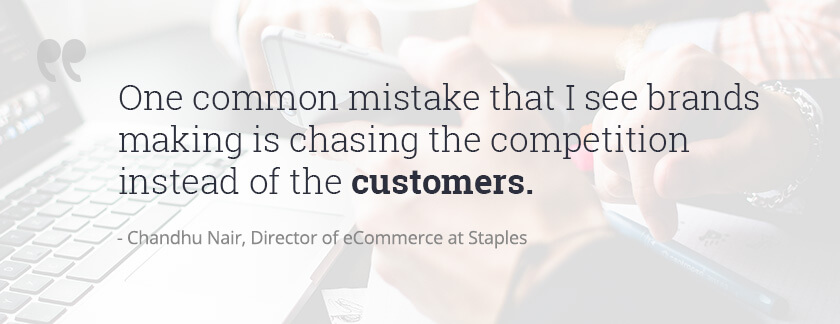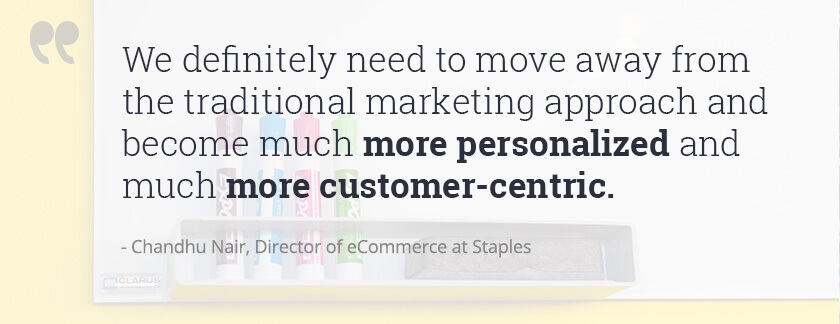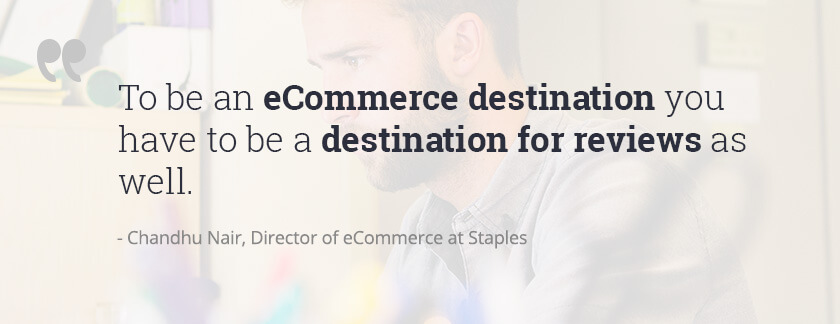Staples is a strategic leader in eCommerce that is not content to rest on their laurels. Though the company consistently tops eCommerce lists, they constantly innovate to ensure the best experience for their customers. Through research, data analysis, discovery with Staples Innovation Labs program and partnering with startups, Staples stays ahead of the curve when it comes to eCommerce marketing and strategy.
So it only makes sense that our interview with Staples’ Director of eCommerce, Chandhu Nair focuses on the future of the eCommerce industry. Chandhu explains what he thinks eCommerce will evolve into, the mistakes he sees companies making and how digital marketing needs to change to adapt to current trends.
You’ll notice the word “experience” comes up a lot — that’s because Staples is not just about transactions but rather building an amazing end to end experience for all of their customers.
Where do you think eCommerce is going?
The future of eCommerce is going to depend on customer experiences built around two key paradigms – “Predictive replenishment” versus “Personalized Shopping”.
The predictive replenishment experience refers to all the things that a customer needs on a regular basis and nobody wants to spend time — online, on mobile or in person — buying. People expect these things to be replenished and at their doorstep when they need it at the best prices. It will come down to who can skillfully stitch together connected devices and big data to anticipate those needs so eventually the customer won’t even have to bother being involved in mundane “buying” tasks.
Then there’s the personalized shopping experience – for the stuff people enjoy shopping for – not your general online merchandising but things that are part of your lifestyle. Here, there needs to be an aspect of entertainment and personalization. It’s also a social play. It will drive a different buying behavior and experience in eCommerce going forward.
What frustrates you about the current state of eCommerce?
One of the frustrations I have with the current state is the lack of a well connected physical and online shopping experiences in the marketplace – in most cases even the basics are missing – the stores don’t even know what the customers bought online and vice versa.
There seems to be a very “inside-out” approach from most e-tailers in building their omni-channel strategy while it should be “outside-in” – customer first and channel agnostic.
Another area of concern is that very few players in the market have adopted the mobile strategy successfully. It is a big opportunity as far as getting your store closer to your customer when & where they want it – but you have to do it right.
It is not about just copying the online experience into mobile but about the importance of building a mobile-specific experience and keeping it relevant to various new device form factors and technology changes. You have to be on top of technology adoption game to keep up with this ever-changing landscape!

Where are you seeing other brands fail to keep up with the trends or changes in eCommerce?
One common mistake that I see brands making is chasing the competition instead of the customers. There is a general tendency to copy all the amazing stuff that the big eCommerce players have built, but then you are just playing catch up. And worse, they are trying to build the same experiences without taking the time to see whether or not it applies to their customer base.
At Staples, we keep the focus on our customers. For example, we’re unique because we are very B2B-focused and we need to build an experience that’s specific to those customers. This again needs to be different for SMBs versus Enterprise customers. If we just tried to copy what other players were doing, we wouldn’t be doing justice to our customers.
Lately, there’s a lot of buzz about bringing the offline experience online or vice versa. Do you agree, or do you think they’re two totally separate experiences?
I would go back to the customer. As a customer, it doesn’t really matter where exactly I am shopping — whether it’s online or offline– because I think of a brand like Staples as one store. Whether that’s a webstore, a physical store or a mobile store, it doesn’t really matter.
The offline experience was developed when there was just brick & mortar, the online experience was curated by pure play eCommerce stores. So, the trick is not bringing one into the other, but getting the two spheres to connect in a meaningful way.

How are you using feedback from your customers to improve their experiences online and offline?
We have many channels of feedback, one aspect of that is product reviews.
Consulting product reviews has become a fundamental step in the purchasing cycle for all types of products and services directly influencing conversion both online and offline. I think that, by definition, to be an eCommerce destination for your customers you have to be a destination for reviews as well.
We’ve seen a 50% increase in conversion in terms of people who are interacting with reviews versus those who are not.
With reviews you can provide that transparency — if a product is not actually good, it’s not good, I think the customers will reward you for being transparent there. There’s no point in hiding it. You should invite customers to participate.
We also take the reviews feedback seriously and have different teams working our assortment mix to improve existing products and find ideas for new ones. Even with something as simple as the product description, if we see a lot of reviews saying “This was bigger than I expected” then we know we need to update the product content. After all, it boils down to right product, right price and best customer experience!
We also look at direct customer feedback on their shopping experience itself. This has helped us make so many incremental changes to site improving the experience and reducing friction. Every morning the eCommerce leadership team gets the previous day’s customer feedback summary email on various aspects of our web, store and mobile experiences.
Trust me – it’s not the best email you want to read in the morning but there are always things you can learn. You realize some of the functional pain points that you put customers through. It’s an amazing program, because we are able to channel the feedback to the appropriate teams whether it’s web engineering, content, shipping & delivery, and make meaningful changes to that experience.
That’s the tactical side. Strategically, you can start consolidating the feedback into data lakes and mine the data for key customer insights which can then be leveraged for new business opportunities or complimentary offerings for our customers – for example, by looking at different segments of customers.
Then start looking to see ‘Is there something we are doing for one segment of customers that doesn’t work for another? Is that why we are getting a different kind of feedback from, let’s say, small business versus mid-market. Does the same apply for our print business – How can we adapt to that?’
What’s your take on this trend in eCommerce of this shifting from brand marketing to a more personalized and customer centric marketing approach?
It’s similar to what I mentioned before, with the online versus mobile stores, where the industry would copy the online experience for mobile instead of thinking about the mobile experience on its own. In my view, we’re at the same point with digital marketing — people are still trying to take traditional marketing methods and just digitize it without really thinking about how it will be consumed by the customers.
We definitely need to move away from the traditional marketing approach and become much more personalized and much more customer-centric.
For example, the social-sharing aspect; being able to share something like a purchase or a review on Facebook or LinkedIn or Twitter — how does that bring in a very forum-like or collaborative environment? How can that be used to build trust? Digital marketing needs to take on the challenge of building trust, not just changing a print/flyer for email.
We are focused right now on shifting some of the trends- this is where customer feedback is key in all aspects; so is social play and transparency. It is not just about having the data and insights – but how to leverage it the best to create customer affinity!




